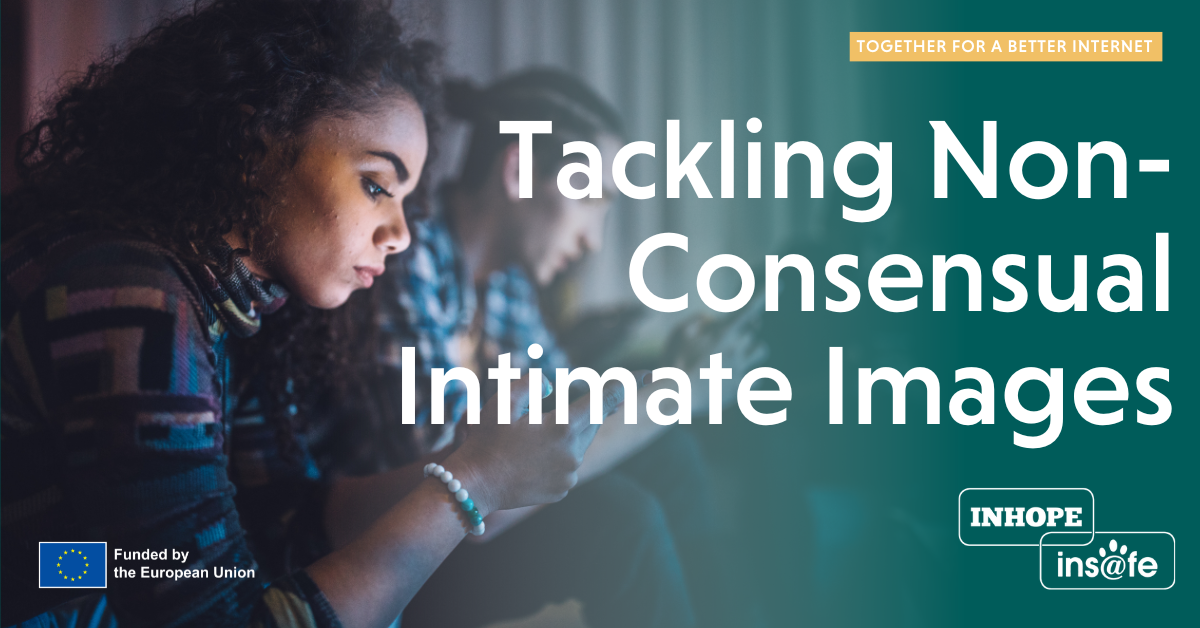Article
Educational Articles
Events & Campaigns
Preventing NCII
If we want to successfully tackle non-consensual intimate image (NCII) abuse, first we need to understand what it actually means. As NCII can encompass several types of material captured under different circumstances, there are still big discrepancies in how we address this type of abuse. If you don't know what NCII is, please read this article before you continue reading.
The Rise of NCII
Over the last couple of years, INHOPE member hotlines have witnessed a trend in increasing reports of NCII and self-generated child sexual abuse material (CSAM). The material is either produced consensually or as a result of grooming or sextortion by perpetrators online. In many cases, offenders will use an initially exchanged image to threaten and further extort sexual material from their victim.
But it's not always adult men online perpetrating this type of exploitation. Unfortunately, NCII is very commonly committed by young people themselves. Research shows that many young people regard taking and sharing nude images as a natural part of their sexual development. And while sexual exploration is a normal part of adolescence, many don't understand the impact it can have if material lands in the wrong hands.
The Normalisation of Sexual Content
But why are we seeing this increase in self-generated content by young people resulting in NCII abuse? The normalisation of sexual material online, as well as the immediate access to instant sharing technology, are two reasons that can explain the rise of this material.
Over time, sexually explicit content has shifted, from only being featured on adult websites to being advertised on mainstream online platforms. On the internet, young people are constantly exposed to content that normalises and even encourages the production of sexually explicit content, usually for financial gain.
Instant access to technology means that children can capture and share a private image within seconds, anywhere they are. And even those who might understand the potential ramifications can make the mistake of sharing an explicit image, based on a snap decision. Especially to victims of grooming or sextortion taking a picture can misleadingly seem like a quick solution to avoid further harm.
The Impact
Experiencing this kind of exploitation can cause long-lasting psychological consequences and leave victims feeling powerless and violated. NCII can be perpetrated by anyone and affect anyone, irrespective of age and gender. But especially for young children and teenagers, the impact can be devastating and cause low self-esteem, isolation, bullying, depression, self-harm, and suicidal thoughts or suicide. What can be especially devastating is not just the initial publication but the following circulation of the content for prolonged periods of time.
Preventing NCII – Together for a better internet
Tackling NCII starts with addressing the current state of our digital education. The digital landscape is changing at a rapid rate, and it becomes increasingly difficult for school curriculums to catch up. But in order to protect young people the threats of sexual exploitation and NCII must become openly addressed topics in educational facilities. Taking into account the normalisation of sexual content online, it is essential that young kids are informed about all associated risks and learn that anything they share online is out of their control, no matter how much they might trust the recipient of the material.
As NCII is often perpetrated by young people themselves, education must not only focus on the dangers of capturing intimate images but has to address how much harm it can cause to peers when their intimate content is published or circulated without their consent.
A Global Effort
Fighting for a better internet is a collaborative effort. Therefore we'd like to highlight campaigns and resources created by our global network of hotlines addressing NCII among young people.
- The French hotline Point de Contact published an educational comic strip educating young people about NCII and how a situation can turn into harassment and cause long-term psychological consequences to the victims.
- ECPAT Sweden has published resources for children whose intimate images are being circulated against their will.
- In collaboration with Revenge Porn Helpline from the U.K., SafeLine.gr brought to Greece a new innovative tool designed to support victims of non-consensual intimate image abuse.
If you’ve come across sexual content of yourself or another minor, contact your local hotline to have it removed by clicking here.
Safer Internet Day would not be possible without the support of the European Union. Currently, the funding is provided by the Connecting Europe Facility programme (CEF). In the future, actions will be funded through the Digital Europe Programme (DIGITAL). Find out more about the European Commission’s new European strategy for a better internet for kids (BIK+) on the EC website.

Instant access to technology means that children can capture and share a private image within seconds, anywhere they are.
'